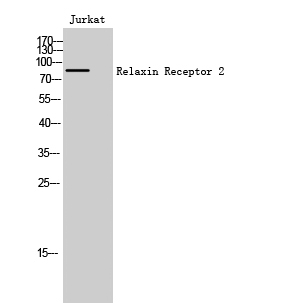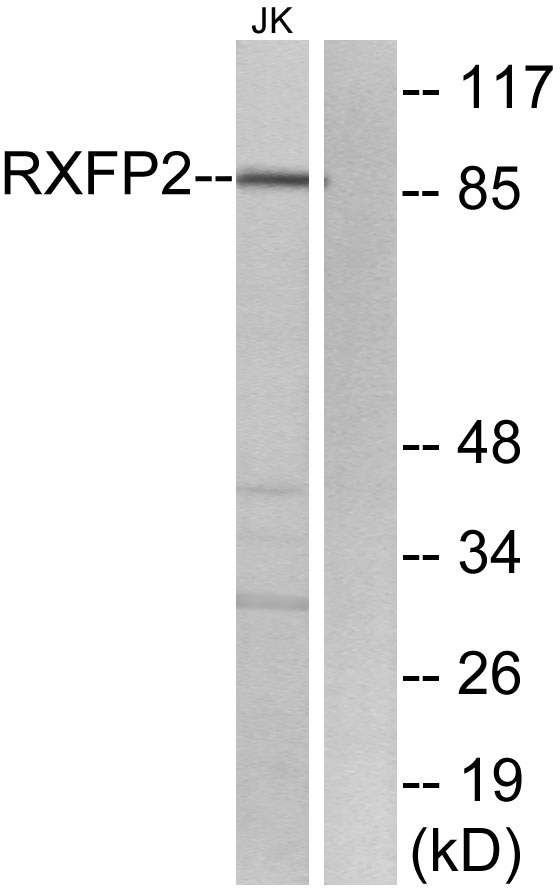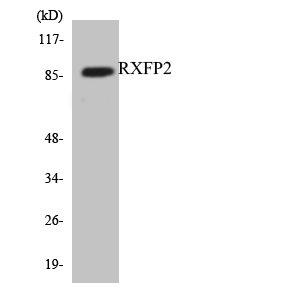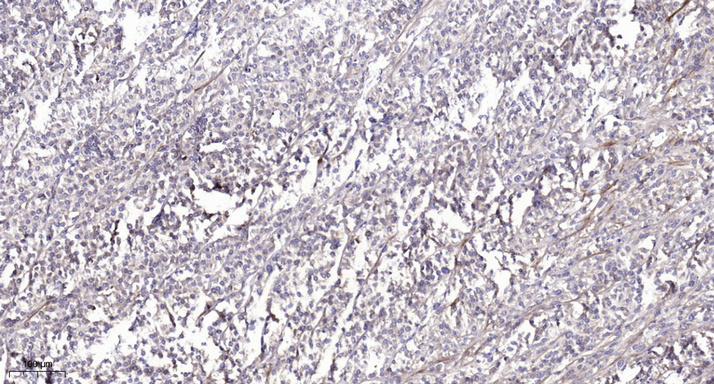Relaxin Receptor 2 Polyclonal Antibody
- Catalog No.:YT4042
- Applications:WB;IHC
- Reactivity:Human;Mouse;Rat
- Target:
- Relaxin Receptor 2
- Fields:
- >>Neuroactive ligand-receptor interaction;>>Relaxin signaling pathway
- Gene Name:
- RXFP2
- Protein Name:
- Relaxin receptor 2
- Human Gene Id:
- 122042
- Human Swiss Prot No:
- Q8WXD0
- Mouse Gene Id:
- 140498
- Mouse Swiss Prot No:
- Q91ZZ5
- Immunogen:
- The antiserum was produced against synthesized peptide derived from human RXFP2. AA range:113-162
- Specificity:
- Relaxin Receptor 2 Polyclonal Antibody detects endogenous levels of Relaxin Receptor 2 protein.
- Formulation:
- Liquid in PBS containing 50% glycerol, 0.5% BSA and 0.02% sodium azide.
- Source:
- Polyclonal, Rabbit,IgG
- Dilution:
- WB 1:500-2000;IHC 1:50-300
- Purification:
- The antibody was affinity-purified from rabbit antiserum by affinity-chromatography using epitope-specific immunogen.
- Concentration:
- 1 mg/ml
- Storage Stability:
- -15°C to -25°C/1 year(Do not lower than -25°C)
- Other Name:
- RXFP2;GPR106;GREAT;LGR8;Relaxin receptor 2;G-protein coupled receptor 106;G-protein coupled receptor affecting testicular descent;Leucine-rich repeat-containing G-protein coupled receptor 8;Relaxin family peptide receptor 2
- Observed Band(KD):
- 86kD
- Background:
- This gene encodes a member of the GPCR (G protein-coupled, 7-transmembrane receptor) family. Mutations in this gene are associated with cryptorchidism. Alternatively spliced transcript variants encoding different isoforms have been found for this gene.[provided by RefSeq, Oct 2009],
- Function:
- caution:It is uncertain whether Met-1 or Met-18 is the initiator.,disease:Defects in RXFP2 are a cause of cryptorchidism [MIM:219050]; also known as impaired testicular descent. It is one of the most frequent congenital abnormalities in humans, involving 2-5% of male births. Cryptorchidism is associated with increased risk of infertility and testicular cancer.,function:Receptor for relaxin. The activity of this receptor is mediated by G proteins leading to stimulation of adenylate cyclase and an increase of cAMP. May also be a receptor for Leydig insulin-like peptide (INSL3).,similarity:Belongs to the G-protein coupled receptor 1 family.,similarity:Contains 1 LDL-receptor class A domain.,similarity:Contains 10 LRR (leucine-rich) repeats.,tissue specificity:Expressed mainly in the brain, kidney, muscle, testis, thyroid, uterus, peripheral blood cells and bone marrow.,
- Subcellular Location:
- Cell membrane; Multi-pass membrane protein.
- Expression:
- Expressed mainly in the brain, kidney, muscle, testis, thyroid, uterus, peripheral blood cells and bone marrow.
- June 19-2018
- WESTERN IMMUNOBLOTTING PROTOCOL
- June 19-2018
- IMMUNOHISTOCHEMISTRY-PARAFFIN PROTOCOL
- June 19-2018
- IMMUNOFLUORESCENCE PROTOCOL
- September 08-2020
- FLOW-CYTOMEYRT-PROTOCOL
- May 20-2022
- Cell-Based ELISA│解您多样本WB检测之困扰
- July 13-2018
- CELL-BASED-ELISA-PROTOCOL-FOR-ACETYL-PROTEIN
- July 13-2018
- CELL-BASED-ELISA-PROTOCOL-FOR-PHOSPHO-PROTEIN
- July 13-2018
- Antibody-FAQs
- Products Images

- Western Blot analysis of Jurkat cells using Relaxin Receptor 2 Polyclonal Antibody

- Western blot analysis of lysates from Jurkat cells, using RXFP2 Antibody. The lane on the right is blocked with the synthesized peptide.

- Western blot analysis of the lysates from HUVECcells using RXFP2 antibody.

- Immunohistochemical analysis of paraffin-embedded human Colon cancer. 1, Antibody was diluted at 1:200(4° overnight). 2, Tris-EDTA,pH9.0 was used for antigen retrieval. 3,Secondary antibody was diluted at 1:200(room temperature, 45min).



